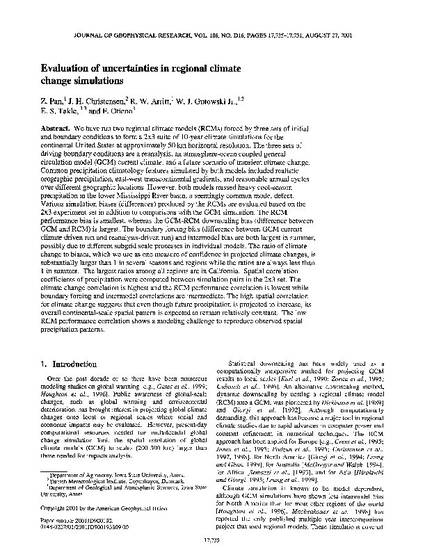
We have run two regional climate models (RCMs) forced by three sets of initial and boundary conditions to form a 2×3 suite of 10-year climate simulations for the continental United States at approximately 50 km horizontal resolution. The three sets of driving boundary conditions are a reanalysis, an atmosphere-ocean coupled general circulation model (GCM) current climate, and a future scenario of transient climate change. Common precipitation climatology features simulated by both models included realistic orographic precipitation, east-west transcontinental gradients, and reasonable annual cycles over different geographic locations. However, both models missed heavy cool-season precipitation in the lower Mississippi River basin, a seemingly common model defect. Various simulation biases (differences) produced by the RCMs are evaluated based on the 2×3 experiment set in addition to comparisons with the GCM simulation. The RCM performance bias is smallest, whereas the GCM-RCM downscaling bias (difference between GCM and RCM) is largest. The boundary forcing bias (difference between GCM current climate driven run and reanalysis-driven run) and intermodel bias are both largest in summer, possibly due to different subgrid scale processes in individual models. The ratio of climate change to biases, which we use as one measure of confidence in projected climate changes, is substantially larger than 1 in several seasons and regions while the ratios are always less than 1 in summer. The largest ratios among all regions are in California. Spatial correlation coefficients of precipitation were computed between simulation pairs in the 2×3 set. The climate change correlation is highest and the RCM performance correlation is lowest while boundary forcing and intermodel correlations are intermediate. The high spatial correlation for climate change suggests that even though future precipitation is projected to increase, its overall continental-scale spatial pattern is expected to remain relatively constant. The low RCM performance correlation shows a modeling challenge to reproduce observed spatial precipitation patterns.
Available at: http://works.bepress.com/william-gutowski/49/

This article is from Journal of Geophysical Research: Atmospheres 106 (2001): 17735–17751, doi:10.1029/2001JD900193. Posted with permission.